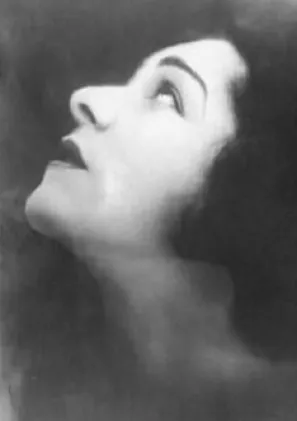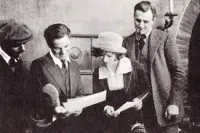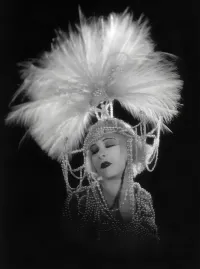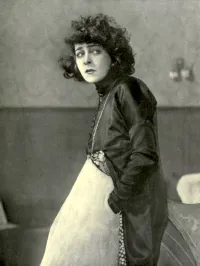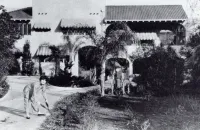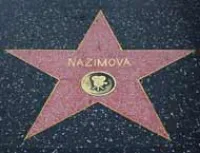Biography
1879 - 1945
"Sincerity and the correct use of the voice are the greatest things in the art of acting."
- Alla Nazimova
After studying acting with Stanislavsky, Alla Nazimova came to America in 1905 and triumphed on Broadway in Enrik Ibsen’s plays ‘Hedda Gabler’ and ‘A Doll’s House.’ By 1916 the flamboyant “Nazimova” had embarked on a film career and in short order became the highest paid actress at Metro. Known for playing glamorous but anguished heroines, some of her productions were extravagant failures; neither her art deco “modernization” of ‘Camille’ (1921) nor her scandalous film version of Oscar Wilde’s ‘Salome’ (1923) – complete with a gay and lesbian cast and crew – proved successful. Her career was already on the wane when The Motion Picture Production Code of 1930 dealt it a final blow. The Code – which forbade immorality or impropriety on screen – was applied to the private lives of actors as well. Drugs, infidelity, promiscuity, and especially homosexuality were all taboo. Nazimova’s ‘lavender relationship’ to gay actor Charles Bryant fooled no one. Her home, “The Garden of Alla,” a 3.5 acre estate on Sunset Boulevard, was reputed to be ground zero for the industry’s lesbian and bisexual women’s community, which Nazimova referred to as her “sewing circle.” At the height of her career she had earned a reputation as a lady-killer with legendary conquests that included Tallulah Bankhead, Eva Le Gallienne, Jean Acker, director Dorothy Arnzer, writer Mercedes de Acosta, and Anna May Wong. When her personal fortunes turned for the worse she went from renting her estate to renting a single room within it. Later in her life Nazimova – who was godmother to future First Lady Nancy Reagan – enjoyed some additional stage success and smaller film parts, but it was a sad postscript to what had been an extraordinary career. At age 66 she died of a coronary thrombosis.
1879 - 1945
"Sincerity and the correct use of the voice are the greatest things in the art of acting."
- Alla Nazimova
After studying acting with Stanislavsky, Alla Nazimova came to America in 1905 and triumphed on Broadway in Enrik Ibsen’s plays ‘Hedda Gabler’ and ‘A Doll’s House.’ By 1916 the flamboyant “Nazimova” had embarked on a film career and in short order became the highest paid actress at Metro. Known for playing glamorous but anguished heroines, some of her productions were extravagant failures; neither her art deco “modernization” of ‘Camille’ (1921) nor her scandalous film version of Oscar Wilde’s ‘Salome’ (1923) – complete with a gay and lesbian cast and crew – proved successful. Her career was already on the wane when The Motion Picture Production Code of 1930 dealt it a final blow. The Code – which forbade immorality or impropriety on screen – was applied to the private lives of actors as well. Drugs, infidelity, promiscuity, and especially homosexuality were all taboo. Nazimova’s ‘lavender relationship’ to gay actor Charles Bryant fooled no one. Her home, “The Garden of Alla,” a 3.5 acre estate on Sunset Boulevard, was reputed to be ground zero for the industry’s lesbian and bisexual women’s community, which Nazimova referred to as her “sewing circle.” At the height of her career she had earned a reputation as a lady-killer with legendary conquests that included Tallulah Bankhead, Eva Le Gallienne, Jean Acker, director Dorothy Arnzer, writer Mercedes de Acosta, and Anna May Wong. When her personal fortunes turned for the worse she went from renting her estate to renting a single room within it. Later in her life Nazimova – who was godmother to future First Lady Nancy Reagan – enjoyed some additional stage success and smaller film parts, but it was a sad postscript to what had been an extraordinary career. At age 66 she died of a coronary thrombosis.
Demography
Demography
Gender Female
Sexual Orientation Lesbian
Gender Identity Cisgender
Ethnicity Caucasian/White
Nations Affiliated Russia United States
Era/Epoch Jazz Age (1910-1940) Roaring Twenties (1920-1929)
Field(s) of Contribution
Film
Theater
Commemorations & Honors
Hollywood Walk of Fame Star For Motion Pictures (1960)
Demography
Gender Female
Sexual Orientation Lesbian
Gender Identity Cisgender
Ethnicity Caucasian/White
Nations Affiliated Russia United States
Era/Epoch Jazz Age (1910-1940) Roaring Twenties (1920-1929)
Field(s) of Contribution
Film
Theater
Commemorations & Honors
Hollywood Walk of Fame Star For Motion Pictures (1960)
Resources
Resources
Resources
